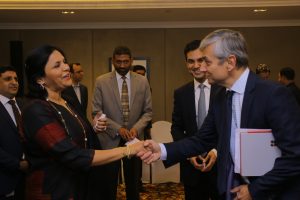Jean-Philippe Courtois meets customers in Asia who are using technology to address huge challenges
There are places I visit that have a remarkable habit of changing, beyond recognition, each time I return. Asia is one. Such a diverse and vibrant continent, Asia has its challenges, but it is also full of opportunity, innovation and ambition.
I recently visited three fascinating countries: China, Japan and India. While each market is unique, they share a belief in technology, with customers using it to capture some huge opportunities.
Nationwide digital transformation
China’s GDP growth has averaged almost 10 percent a year over the last four decades, the fastest by a major economy in history. This ambitious country now finds itself at a crossroads. To continue to grow, it must move from an investment and labor-intensive economy to an innovation-led economy.
To achieve this, China’s leadership has set ambitious goals around digital transformation, driving national policies that reach public and private organizations. Made in China 2025 and Internet Plus are two such initiatives. Designed to upgrade Chinese industry, the country is replacing existing systems, connecting IoT (Internet of Things) devices and working intelligently with data to propel the economy forward.
 But China is home to more than a billion people. Evolution on this scale requires close partnership with similarly ambitious organizations who understand the challenges and the nuances of this vibrant marketplace. Microsoft’s own program, Innovation Squared, aims to spark innovation from the ground up.
But China is home to more than a billion people. Evolution on this scale requires close partnership with similarly ambitious organizations who understand the challenges and the nuances of this vibrant marketplace. Microsoft’s own program, Innovation Squared, aims to spark innovation from the ground up.
This means helping entrepreneurs like Joe Xia, co-founder and CTO of Mobike, who led automotive companies Ford and Fiat, and holds more than 20 utility model inventions, patents and software copyrights. His passion for innovation takes bike rental entirely online, making it simple to drop off your bike at any roadside public parking area. Built on our China Azure cloud platform, Mobike is a company that embodies the digital transformation taking place in China and is a business primed for global expansion.
Boosting the workforce through technology
In Japan, I saw a country addressing different challenges. With Japan’s elderly population growing and its younger population shrinking, it faces a major hurdle in managing nationwide productivity. It was fascinating to see how the country is tackling its demographic challenges with technology.
For example, with the 2020 Olympics and Paralympics fast approaching, there is considerable pressure to deliver on infrastructure projects like stadiums and transport networks. The construction companies I met are looking at the latest technologies to get the job done effectively. For example, Kajima is automating machinery such as bulldozers to address staff shortages, and Taisei is making the most of its talent by helping them work on multiple sites from one location using our technologies.
Delivering better patient care
With the same focus on technology, India is driving digital transformation, too, through the Indian Government’s Digital India program, which aims to transform the country into a digitally powered economy. We support this ambitious plan, and believe that a strong cloud platform is the key to enabling the delivery of exceptional services to over 1.2 billion people.
I saw how leading healthcare providers are doing this right now. L V Prasad Eye Institute is using Azure Machine Learning and Power BI to predict the final surgical outcome of eye surgery patients. Using a predictive model that helps calculate regression rates for eye operations, doctors can pinpoint the procedures needed to prevent and treat visual impairments. Using the data, doctors can also better understand the risks involved for a particular patient, which leads to more effective treatment while reducing costs.
This work is now being expanded to other markets across the world through the Microsoft Intelligent Network for Eyecare (MINE), a new global eye-care consortium of academic and research organizations. Launched by Microsoft India and LVPEI this week, MINE will use artificial intelligence to help eliminate avoidable blindness and scale up delivery of eye-care services worldwide.
MINE partners include Bascom Palmer, University of Miami (USA); Flaum Eye Institute, University of Rochester (USA); Federal University of Sao Paulo (Brazil) and Brien Holden Vision Institute (Australia).
MINE will examine patient data across geographies and use machine learning to develop predictive models for tackling vision impairment and eye disease. The consortium will collaborate on myopia in children, conditions that impact children’s eyesight, predictive outcomes of refractive surgery, optimal surgery parameters and ways to personalize surgery to maximize probability of success.
Leading the way
In different ways, these countries are blazing a trail in digital transformation. They’re working out how to use technology at micro and macro levels, fueling the engine of change with cloud, data analytics and Artificial Intelligence (AI). These are the technologies that will propel people, organizations and entire economies into the future.
Jean-Philippe Courtois is executive vice president, and president of Microsoft Global Sales, Marketing and Operations. Based in Paris, Courtois travels to every country where Microsoft has an office. Spending time with our customers, partners and employees, he has a unique perspective on the transformative impact of technology.








